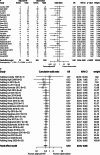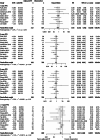Adjuvant radiotherapy versus observation following gross total resection for atypical meningioma: a systematic review and meta-analysis
- PMID: 33596974
- PMCID: PMC7890913
- DOI: 10.1186/s13014-021-01759-9
Adjuvant radiotherapy versus observation following gross total resection for atypical meningioma: a systematic review and meta-analysis
Abstract
Background: The impact of adjuvant radiotherapy (RT) on atypical meningioma (AM) underwent a gross total resection (GTR) remains unclear, showing conflicting results from various studies. The objective of this study was to perform an updated meta-analysis for observational studies to determine the effect of adjuvant RT after GTR on local recurrence and survival outcomes compared to observation after GTR.
Methods: PubMed, Embase, and Web of Science were searched to identify comparative studies that reported outcomes of adjuvant RT versus observation for AM patients after GTR. Local recurrence rate, progression-free survival (PFS), overall survival (OS), and toxicities related to RT were considered as outcomes of interest. Differences between two cohorts were estimated by calculating odds ratios (OR) for LR rate and hazard ratios (HR) for survival outcomes with 95% confidence intervals (CIs) for meta-analysis, using R version 4.0.3 software. Included studies were appraised with the Risk of Bias Assessment tool for Non-Randomized Studies. Outcome ratios were combined with the Mantel-Haenszel method and the inverse variance-weighted method, appropriately.
Results: Data from 30 studies involving 2904 patients (adjuvant RT: n = 737; observation: n = 2167) were eventually included. Significant reduction of local recurrence rate was seen in the adjuvant RT cohort compare to that in the observation cohort (OR 0.50; 95% CI 0.36-0.68; p < 0.0001). Pooled HRs of PFS at 1-year, 3-year, 5-year, and > 5-year revealed that adjuvant RT was superior to observation. There was no significant difference in OS between the two cohorts during any period. Most toxicities were tolerable with grade 1 or 2. There was no documented grade 5 toxicity.
Conclusions: For AM patients who underwent GTR, evidence suggested that adjuvant RT could potentially decrease local recurrence and improve PFS better than observation.
Keywords: Adjuvant; Atypical meningioma; Gross total resection; Postoperative; Radiotherapy.
Conflict of interest statement
The authors have no conflicts of interest relevant to this study to disclose.
Figures





Similar articles
-
Revisiting Adjuvant Radiotherapy After Gross Total Resection of World Health Organization Grade II Meningioma.World Neurosurg. 2017 Jul;103:655-663. doi: 10.1016/j.wneu.2017.04.095. Epub 2017 Apr 24. World Neurosurg. 2017. PMID: 28450233
-
Should adjuvant radiotherapy be used in atypical meningioma (WHO grade 2) following gross total resection? A systematic review and Meta-analysis.Acta Oncol. 2022 Sep;61(9):1075-1083. doi: 10.1080/0284186X.2022.2116994. Epub 2022 Sep 2. Acta Oncol. 2022. PMID: 36052871
-
Intermediate-risk meningioma: initial outcomes from NRG Oncology RTOG 0539.J Neurosurg. 2018 Jul;129(1):35-47. doi: 10.3171/2016.11.JNS161170. Epub 2017 Oct 6. J Neurosurg. 2018. PMID: 28984517 Free PMC article. Clinical Trial.
-
Overall survival benefit associated with adjuvant radiotherapy in WHO grade II meningioma.Neuro Oncol. 2017 Sep 1;19(9):1263-1270. doi: 10.1093/neuonc/nox007. Neuro Oncol. 2017. PMID: 28371851 Free PMC article.
-
Surgery alone versus surgery plus adjuvant radiotherapy for WHO grade 2 meningioma: meta-analysis of reconstructed time-to-event data.Neurosurg Rev. 2024 Sep 28;47(1):702. doi: 10.1007/s10143-024-02946-4. Neurosurg Rev. 2024. PMID: 39333271
Cited by
-
Long-Term Follow-Up, Treatment Strategies, Functional Outcome, and Health-Related Quality of Life after Surgery for WHO Grade 2 and 3 Intracranial Meningiomas.Cancers (Basel). 2022 Oct 14;14(20):5038. doi: 10.3390/cancers14205038. Cancers (Basel). 2022. PMID: 36291821 Free PMC article.
-
Differentiating angiomatous meningioma from atypical meningioma using histogram analysis of apparent diffusion coefficient maps.Quant Imaging Med Surg. 2023 Jul 1;13(7):4160-4170. doi: 10.21037/qims-22-1224. Epub 2023 May 8. Quant Imaging Med Surg. 2023. PMID: 37456320 Free PMC article.
-
Paired Primary and Recurrent Rhabdoid Meningiomas: Cytogenetic Alterations, BAP1 Gene Expression Profile and Patient Outcome.Biology (Basel). 2024 May 16;13(5):350. doi: 10.3390/biology13050350. Biology (Basel). 2024. PMID: 38785832 Free PMC article.
-
Improved quantification of tumor adhesion in meningiomas using MR elastography-based slip interface imaging.PLoS One. 2024 Jun 25;19(6):e0305247. doi: 10.1371/journal.pone.0305247. eCollection 2024. PLoS One. 2024. PMID: 38917107 Free PMC article.
-
A Case Report Depicting a Rare Neurosurgical Disease: Aggressive Meningiomatosis.J Clin Med. 2025 Apr 16;14(8):2731. doi: 10.3390/jcm14082731. J Clin Med. 2025. PMID: 40283561 Free PMC article.
References
-
- Bulleid LS, James Z, Lammie A, Hayhurst C, Leach PA. The effect of the revised WHO classification on the incidence of grade II meningioma. Br J Neurosurg. 2019;9:1–3. - PubMed
Publication types
MeSH terms
LinkOut - more resources
Full Text Sources
Other Literature Sources

